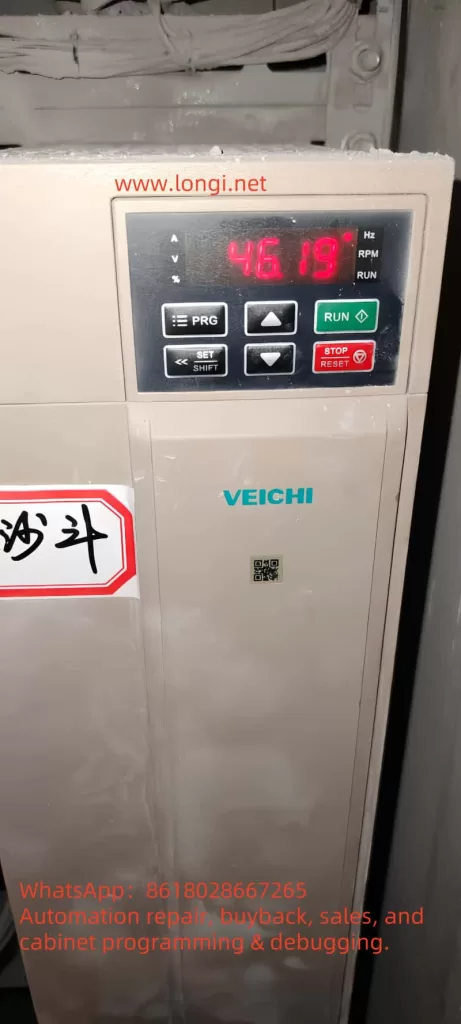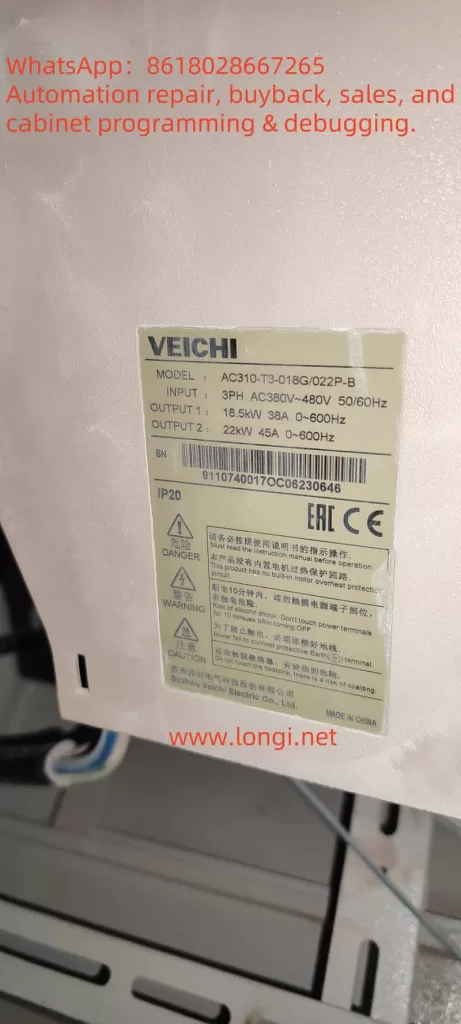I. Detailed Explanation of Operation Panel Functions
1. Overview of Operation Panel Functions
The VEIHI Inverter AC310 series operation panel integrates multiple functions, supporting parameter settings, operational control, and fault diagnosis. Key functions include:
- Display Screen: Displays operational status, parameter values, and fault codes.
- Run Key: Starts/stops the inverter.
- Up/Down Keys: Adjust parameter values or select menu items.
- Confirm/Shift Key: Confirms settings or switches operation positions.
- Menu Key: Enters the function menu interface.
- Stop/Reset Key: Stops operation or resets faults.
2. Factory Parameter Settings
- Enter Parameter Settings: Press the “Menu Key” → Select “Parameter Settings”.
- Select Parameter Group: Use the up/down keys to choose a parameter group (e.g., F00, F01).
- Modify Parameter Values: After selecting a parameter, adjust its value with the up/down keys and press “Confirm/Shift Key” to save.
- Restore Factory Defaults: Press the “Menu Key” → Select “Restore Factory Defaults” → Confirm.
3. Password Setting and Removal
- Set Password:
- Press the “Menu Key” → Select “Password Settings”.
- Enter the default password (0000) → Press “Confirm/Shift Key” to save.
- Remove Password:
- Press the “Menu Key” → Select “Password Settings”.
- Enter the current password → Press “Confirm/Shift Key” → Reset the password to 0000.
4. Parameter Access Restrictions
- Enter Restriction Settings: Press the “Menu Key” → Select “Parameter Access Restrictions”.
- Set Permissions: Choose a parameter group and set access permissions (e.g., read-only, writable).
- Save Settings: Press “Confirm/Shift Key” to save.

II. External Terminal Control and Speed Regulation Methods
1. External Terminal Forward/Reverse Control
- Wiring: Connect external signals to digital input terminals (e.g., X1, X2) and set terminal functions (Parameter F05.00).
- Parameter Settings:
- F01.01=1 (External Terminal Control).
- Set the corresponding terminal in F05.00 for forward/reverse control.
2. External Potentiometer Frequency Control
- Wiring: Connect the potentiometer output to analog input terminals (e.g., AI1, AI2) and set terminal functions (Parameter F05.04).
- Parameter Settings:
- F01.02=2 (Frequency Reference Source Channel A = Terminal AI1 Reference).
- Set the potentiometer output range in F05.50 and F05.53 (e.g., 0V~10V).
III. Fault Codes and Troubleshooting Methods
1. Common Fault Codes
- E.SC1 (01): System fault during acceleration (short circuit, interference, overload).
- E.oC1 (05): Overcurrent during acceleration (overload, motor damage, too short acceleration time).
- E.Lu (13): Undervoltage during operation (unstable power supply, loose cables).
- E.oH1 (30): Rectifier module overtemperature (poor ventilation, high ambient temperature).
2. Fault Troubleshooting Methods
- System Fault (E.SC1):
- Check the main circuit and eliminate short circuits.
- Shorten the output cable or add an output reactor.
- Reduce the load or replace with a higher-capacity inverter.
- Overcurrent Fault (E.oC1):
- Reduce the load or replace with a higher-capacity inverter.
- Increase the acceleration time (Parameter F01.22).
- Undervoltage Fault (E.Lu):
- Check the stability of the power supply voltage.
- Ensure the cable connections are secure.
- Overtemperature Fault (E.oH1):
- Ensure proper ventilation.
- Lower the ambient temperature or add cooling equipment.

IV. Conclusion and Recommendations
The VEIHI Inverter AC310 series is a powerful and user-friendly variable frequency drive. By properly setting parameters, correctly wiring, and promptly addressing faults, users can fully leverage its performance and ensure stable equipment operation. This guide provides detailed information on operation panel functions, parameter settings, external control and speed regulation methods, and fault troubleshooting steps, offering valuable references for users. If issues arise during use, please contact our technical support team for professional assistance.
